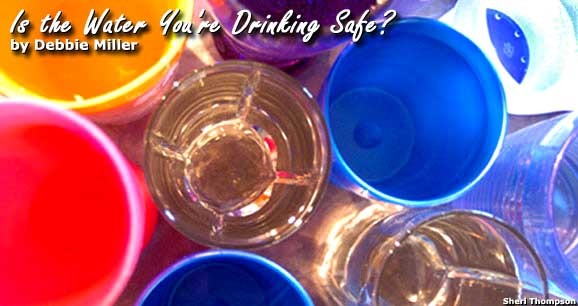
 My brother and his wife were celebrating their 10th anniversary in Cozumel, Mexico, when a hurricane struck. Though they safely made it to a location 60 miles (96 km) south of the hurricane’s wrath, my brother and sister-in-law still spent three days with no electricity or running water in their hotel room. Food was scarce and there was little bottled water.
My brother and his wife were celebrating their 10th anniversary in Cozumel, Mexico, when a hurricane struck. Though they safely made it to a location 60 miles (96 km) south of the hurricane’s wrath, my brother and sister-in-law still spent three days with no electricity or running water in their hotel room. Food was scarce and there was little bottled water.
This situation got me to thinking: What if they had run out of bottled water and all that had been available was tap water, once that got turned back on. Would the water have been safe to drink? How would they know? It helps to be prepared.
In general, drinking bottled water is the best way to go. If that’s not available, you can boil water for three minutes to remove any contamination.
But what if boiling water is not a possibility? It’s a good idea to bring along a small amount of iodine or a water filter to areas where the water source is questionable. According to the Mississippi State University Extension Service, iodine can be used in an emergency. Using 2 percent United States Pharmacopoeia (USP) Tincture of iodine, place 20 drops from a medicine dropper into 1 gallon (3.79 liters) of clear water and 40 drops into cloudy water.
Use a clean container, and shake or stir. Then let the water sit for 30 minutes. Always be sure to store iodine in a safe place, as it’s poisonous in larger amounts. Iodine in the form of purification tablets is available at camping stores, military-surplus stores, sporting-goods stores and large department stores. Follow the directions on the packet carefully.
If you don’t have iodine, bleach can do the trick. Use full-strength, 5.25 percent sodium hypochlorite. Add 1/8 teaspoon to a gallon (4 liters) of clear water or use 1/4 teaspoon for the same amount of cloudy water. Let the water stand for 30 minutes. If, after 30 minutes, the water does not have a slight chlorine smell, add the same amount of bleach again and let it sit for 15 more minutes.
The United States Centers for Disease Control and Prevention (CDC) recommend both mechanically filtering and using chlorine or iodine. In all cases, let the water sit 15 to 60 minutes before drinking.
Outdoor gear retail stores, such as REI, sell water filters and purifier systems. Both filters and water purifiers are microbiological devices that remove bacteria and protozoan cysts from the water. Purifiers offer a higher level of security, since they also removes viruses.
Thankfully, my brother and sister-in-law had just enough bottled water to get them through until they could leave the hurricane-ravaged area. They returned home with tales to tell ― and good insight on the benefits of being prepared.
Healthy Travels!
Author Bio: Debbie Miller is an RN and frequent traveler based in Colorado.
- Top Things to Do with Kids in Kauai, Hawaii - January 13, 2024
- Cinnamon Bay Campgrounds, U.S. Virgin Islands - January 10, 2021
- Colorful Colonia del Sacramento, Uruguay - January 9, 2021
